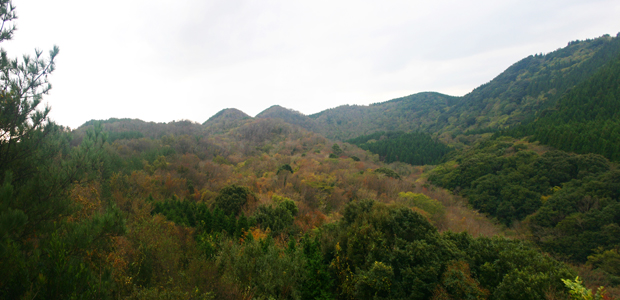
- Updated 2024.4.24 17:16
- All Articles
-
member
icon
-
facebook
cursor
-
twitter
cursor
|
TravelHiking |
Commanding the lava tubesA site of history and mystery |
|
| |
 |
|
| ▲ Geomun Oreum, which sits above the World Heritage Site Geomunoreum Lava Tube System, is itself a natural wonder and home to a variety of flora and fauna. Photos by Kim Hong Gu |
What was it like when volcanoes erupted on Jeju Island? It may have been like the creation with flaming lava erupting and volcanic bombs raining from the sky. The lava which failed to fly further afield flowed down, creating caves and lava valleys.
One crater where the lava came out became a gotjawal, the Jeju name for a forest of bushes and rocks. These days, in the gotjawal, birds fly, animals thrive and plants grow, in a precious natural balance. One representative part of this priceless nature on Jeju is the Geomunoreum Lava Tube System, which is protected as a World Natural Heritage Site. Commanding the center of this area is the oreum from which it takes its name--Geomun Oreum.
If you drive from Jeju City for about 30 minutes on Beonyeong Road, which links the city and Pyoseon, you will arrive at Geomun Oreum Tour Information Center. As this is a World Natural Heritage Site, visitors need to make reservations and take a guided tour. The peak of Geomun Oreum is 456.6 meters above sea level, and it rises for 112 meters from its base.
Professor Shin Youngdae of Cheju Tourism College describes the oreum thus: “It looks as if nine dragons in the clouds are playing with Cintamani [the ball a dragon has in his mouth when he goes up to the sky] surrounded by rolling peaks along the ridge. It feels like being in a secluded place where a noble hermit lives. In the middle of it, Al Oreum, symbolizing Cintamani, commands valleys on the left and right. The oreum forms a deep forest serving as the origin of abyss. The deep valley, seamlessly connected high and low, boasts mysterious changes not revealing the beginning and ending.”
The essence of Geomun Oreum is a lava valley surrounding the crater. Visitors can’t see the valley due to a thick natural forest, from which autumn leaves fall on a winding forest path. Various wetland plants and the forest coexist in harmony, indicating that we human beings should be grateful to just appreciate nature, to which we can attribute our warm hearts. If nature impresses us enough to be moved to protect it, the environmental destruction of thoughtless people may disappear.
Jeju is called the heaven of oreums. Among the many, the Geomunoreum World Natural Heritage Site houses a sleek peak, the gotjawal and many living creatures. Flowing lava created mysterious caves including Bengdui Cave, Man-jang Cave, Kimnyeong Cave, Yongcheon Cave and Dangcheomul Cave. The site is also home to the whitebacked woodpecker, the bush warbler and various plants, including Japanese aucuba and anise trees.
There are three World Natural Heritage Sites on Jeju Island--Hallasan National Park, Seongsan Sunrise Peak and the Geomunoreum Lava Tube System. Mount Halla is the symbol of Jeju Island and is considered one of the three most beautiful mountains in Korea, as well as being the highest. The Seongsan Sunrise Peak tuff cone boasts picturesque scenery near the coast.
All three sites were included as part of the Jeju Volcanic Island and Lava Tubes World Natural Heritage Site in 2007. The lava that erupted from Geomun Oreum approximately 300,000 years ago created many caves, valleys and the gotjawal, which is full of intriguing mystery.
However, the beautiful Geomun Oreum also has a painful history. It harbors within it the heartrending and tragic history of both the Japanese occupation and the April 3 uprising. Mines made by the Japanese Army during the Pacific War remain in the side of the oreum, diluting the history of Jeju. The oreum was also used as a shelter for people during the agonizing April 3 uprising immediately after Korea’s independence. In the past, it was also used by slash-and-burn farmers who baked charcoal and destroyed natural forest to cultivate fields. It became the site of a sorrowful history and even now it is greeting tourists, it still harbors that history.
|
|
|
|
|
|
|
|
ⓒ Jeju Weekly 2009 (http://www.jejuweekly.net)
All materials on this site are protected under the Korean Copyright Law and may not be reproduced, distributed, transmitted, displayed, published without the prior consent of Jeju Weekly. |
|
|
|
|
|

|
| Geomun Oreum, which sits above the World Heritage Site Geomunoreum Lava Tube System, is itself a natural wonder and home to a variety of flora and fauna. Photos by Kim Hong Gu |
|
|
|
| Jeju-Asia's No.1 for Cruise |
|
|
|
Title:The jeju Weekly(제주위클리) | Mail to editor@jejuweekly.net | Phone: +82-64-724-7776 Fax: +82-64-724-7796
#503, 36-1, Seogwang-ro, Jeju-si, Jeju-do, Korea, 63148
Registration Number: Jeju, Ah01158(제주,아01158) | Date of Registration: November 10,2022 | Publisher&Editor : Hee Tak Ko | Youth policy: Hee Tak Ko
Copyright ⓒ 2009 All materials on this site are protected under the Korean Copyright Law and may not be reproduced, distributed, transmitted, displayed, published
without the prior consent of jeju weekly.com.

|






















